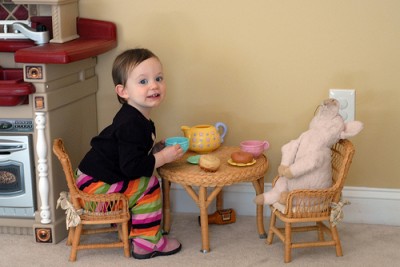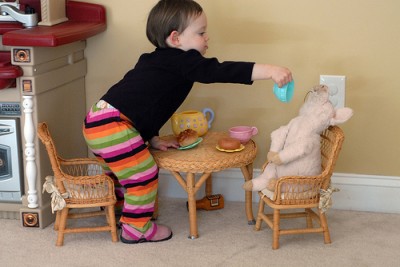 Toys do make a difference in stimulating a child’s speech development. I am constantly reminded of this as I work in homes and see what toy selections some kids have. You don’t have to spend a lot of money on toys, but carefully select toys that will encourage talking and creative play.
Toys do make a difference in stimulating a child’s speech development. I am constantly reminded of this as I work in homes and see what toy selections some kids have. You don’t have to spend a lot of money on toys, but carefully select toys that will encourage talking and creative play.
Recently I was in the home of a 16 month-old who was not talking. She responded beautifully to our first few sessions, using jargon to ask for me to repeat actions like starting a car, blowing bubbles or playing music. When I asked mom to bring out her favorite toys so I could show her how to use them to encourage talking she said her daughter really likes her laptop.
Mom brought out Thomas the Train Learn and Explore Laptop by VTech. This mini-laptop with over 30 games to teach numbers and letters, and a little screen, is designed for children 3-6. No doubt it is fun for that age range, but a 16 month-old simply enjoys pushing the buttons and watching the screen being constantly bombarded with repeated phrases of good job and bye bye. The little girl who had been so vocal was  suddently mesmorized by a toy beyond her age and was silent, unless I tried to get her attention away from it. I suggested that mom put the toy away until she is older and look for toys that are more exciting for stimulting language.
suddently mesmorized by a toy beyond her age and was silent, unless I tried to get her attention away from it. I suggested that mom put the toy away until she is older and look for toys that are more exciting for stimulting language.
Here is what to look for:
- Toys where you can hold back an action or music until the child verbalizes or attempts a word. (Fisher Price Piggy Bank, where you can hold back the coins and give them as the child makes a sound or word, you can wait to open or close the tummy on command too.)
- Toys that are inherently reinforcing. (such as bubbles where you can model “open top” or “off” to open the bubbles and then say, “blow” or “ready, set..go” to start blowing bubbles, and “pop” as you pop them. Kids love bubbles and try hard to ask for more
- Toys where you can repeat simple actions using the same core vocabulary such as pounding blocks through shape sorters so repeat, “block” “bang” “drop” and “clunk.”
- Toys with flexible parts that you need to manipulate to continue play. (such as the Fisher Price Garage with the gate to open and close to let a car run down the ramp)



